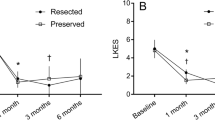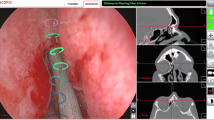Abstract
Background
The population of patients with chronic rhinosinusitis (CRS) has greatly increased. When medical treatment fails, endoscopic sinus surgery (ESS) is considered. In the present study, the value of two different therapies for the middle turbinate to optimize surgical outcomes was observed. Our objective was to determine a better management approach for the middle turbinate to effectively preserve the middle turbinate mucosa and function and avoid complications following ESS, such as nasal adhesions on the operative side.
Methods
Thirty patients [group A; treated prior to 2015 (primary surgery)] undergoing resection of the middle turbinate bone during complete ESS for CRS and 30 patients [group B; treated after 2015 (later surgery)] undergoing middle turbinate preservation and multiapproach therapy during complete ESS for CRS were observed. Nasal cavities were compared using perioperative sinus endoscopy (POSE) and Lund–Kennedy (LKES) scores preoperatively and at 15 days, 2 months and 1 year after ESS.
Results
Preoperatively, the POSE (8.83 ± 3.81 vs 9.15 ± 3.85, p = 0.45, for groups A and B, respectively) and LKES (4.23 ± 0.74 vs 4.13 ± 0.70, p = 0.34) scores were similar between groups. In group A, anterior adhesions were reported on six sides of the middle turbinate, severe adhesions were observed on two sides, mild adhesions were observed on one side, and adhesions occurred on two sides during follow-up. After retreatment, adhesions were still observed on two sides at 1 year. In group B, only mild anterior adhesions were observed on two sides. There was no difference between group A and group B at 15 days, and the POSE (4.31 ± 1.19 vs 4.07 ± 1.42, p = 0.11, for groups A and B, respectively) and LKES (3.35 ± 0.82 vs 3.33 ± 0.90, p = 0.91) scores were similar between groups. There was no significant difference in LKES (0.22 ± 0.49 vs 0.10 ± 0.35, p = 0.15) scores at 1 year between the two groups. There was a significant difference in the nasal cavities between group A and group B at 2 months and 1 year, where group B showed a better endoscopic appearance than group A at 2 months and 1 year (with POSE scores of 3.48 ± 0.83 vs 2.43 ± 1.38 (p = 0.00) and LKES scores of 1.35 ± 0.86 vs 1.15 ± 0.90 (p = 0.02) at 2 months for groups A and B, respectively, and POSE scores of 1.00 ± 0.96 vs 0.62 ± 0.87 (p = 0.001) at 1 year for groups A and B, respectively).
Conclusions
Our results show that middle turbinate preservation and combined therapy was a better ESS method for CRS. Multiapproach middle conchoplasty, which is predominately a submucoperiosteal surgery, can preserve more of the mucosa and functions of the middle turbinate. Unlike the single-approach middle conchoplasty described in previous research, multiapproach middle conchoplasty is achieved by combining a three-step surgical procedure (“surgery, packing and removal”) with “cocktail-style” postoperative packing and removal.




Similar content being viewed by others
Change history
01 August 2020
In the original publication of the article, Fig. 1a was missing and caption of Fig. 1a was published as caption of Fig. 1b. The correct Fig. 1 and captions are provided below.
References
Marchioni D, Alicandri-Ciufelli M, Mattioli F, Marchetti A, Jovic G, Massone F, Presutti L (2008) Middle turbinate preservation versus middle turbinate resection in endoscopic surgical treatment of nasal polyposis. Acta Otolaryngol 128(9):1019–1026
Barham HP, Gould EA, Ramakrishnan VR (2014) Swing technique for middle turbinate preservation in expanded endonasal skull base approaches. Int Forum Allergy Rhinol 4(7):583–586
Choby GW, Hobson CE, Lee S, Wang EW (2014) Clinical effects of middle turbinate resection after endoscopic sinus surgery: a systematic review. Am J Rhinol Allergy 28(6):502–507
Byun JY, Lee JY (2012) Middle turbinate resection versus preservation in patients with chronic rhinosinusitis accompanying nasal polyposis: baseline disease burden and surgical outcomes between the groups. J Otolaryngol Head Neck Surge 41(4):259–264
Soler ZM, Hwang PH, Mace J, Smith TL (2010) Outcomes after middle turbinate resection: revisiting a controversial topic. Laryngoscope 120(4):832–837
Brescia G, Pavin A, Giacomelli L, Boninsegna M, Florio A, Marioni G (2008) Partial middle turbinectomy during endoscopic sinus surgery for extended sinonasal polyposis: short- and mid-term outcomes. Acta Otolaryngol 128(1):73–77
Dadgarnia M, Rahmani A, Baradaranfar M, Atighechi S, Zand V, Meybodian M, Mandegari M (2019) Vaziribozorg S The relationship between endoscopic and radiologic findings and olfactory status of patients with chronic rhinosinusitis with nasal polyps before and after the endoscopic sinus surgery. Eur Arch Oto-rhino-laryngol 276(2):397–400
Du K, Huang Z, Si W, Huang Q, Li C, Wang M, Li Y, Wu Y, Qu J, Zhou B (2020) Dynamic change of T-helper cell cytokines in nasal secretions and serum after endoscopic sinus surgery in chronic rhinosinusitis with nasal polyps. ORL J Oto-rhino-laryngol Relat Spec 82(2):74–85
Hwang CS, Al Sharhan SS, Kim BR, Kim SI, Kim JW, Cho HJ, Yoon JH, Kim CH (2018) Randomized controlled trial of steroid-soaked absorbable calcium alginate nasal packing following endoscopic sinus surgery. Laryngoscope 128(2):311–316
Xu J, Park SJ, Park HS, Han R, Rha KS, Kim YM (2016) Effects of triamcinolone-impregnated nasal dressing on subjective and objective outcomes following endoscopic sinus surgery. Eur Arch Oto-rhino-laryngol 273(12):4351–4357
Giacchi RJ, Lebowitz RA, Jacobs JB (2000) Middle turbinate resection: issues and controversies. Am J Rhinol 14(3):193–197
Friedman M, Landsberg R, Tanyeri H (2000) Middle turbinate medialization and preservation in endoscopic sinus surgery. Otolaryngol Head Neck Surg 123(1 Pt 1):76–80
Bolger WE, Kuhn FA, Kennedy DW (1999) Middle turbinate stabilization after functional endoscopic sinus surgery: the controlled synechiae technique. Laryngoscope 109(11):1852–1853
May M, Levine HL, Mester SJ, Schaitkin B (1994) Complications of endoscopic sinus surgery: analysis of 2108 patients—incidence and prevention. Laryngoscope 104(9):1080–1083
Author information
Authors and Affiliations
Corresponding authors
Ethics declarations
Conflict of interest
The authors declare no conflicts of interest.
Ethical approval
This study was approved by Human Research Ethics Committee in Guangzhou Twelfth People’s Hospital and written consent was obtained from all the participants.
Additional information
Publisher's Note
Springer Nature remains neutral with regard to jurisdictional claims in published maps and institutional affiliations.
The original version of this article was revised due to Fig 1a was missed and caption of Fig 1b was incorrect. The figure 1a, 1b are published correctly in this version.
Rights and permissions
About this article
Cite this article
Zhu, M., Yan, Y., Gong, H. et al. Two different therapies for the middle turbinate during endoscopic sinus surgery for chronic rhinosinusitis. Eur Arch Otorhinolaryngol 277, 3079–3089 (2020). https://doi.org/10.1007/s00405-020-06184-4
Received:
Accepted:
Published:
Issue Date:
DOI: https://doi.org/10.1007/s00405-020-06184-4




